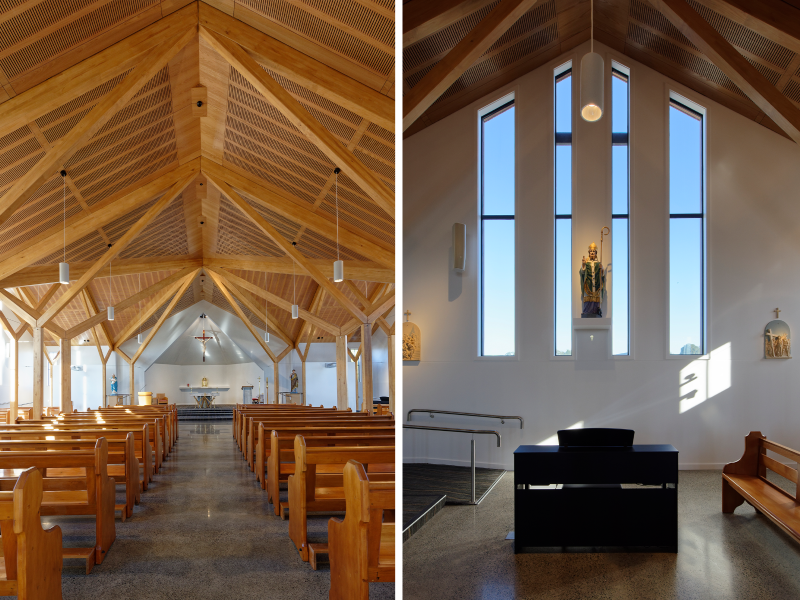The post-quake rebuild of St Patrick’s Catholic Church has been awarded a 4 Green Star rating for its eco-smart design.
Project Snapshot
Owner: Catholic Diocese of Christchurch
Architect: WSP
Engineer: Ruamoko
Main contractor: Armitage Williams Construction
Service engineer: TM Consultants
Project status: Completed May 2019, 10 month new build
Project cost: $3.6 million
Project certification: 4 Green Star Custom Design rating (2020)
Essentials
What: St Patrick’s Catholic Church
Where: 31 Gerald Street, Lincoln
Occupancy: A congregation of 204 people
Located on a prominent intersection in the rural township of Lincoln, St Patrick’s represents the past and future with its traditional cruciform design plan, highly contemporary interior and seamless integration with an existing parish centre and streetscape.
The new-look church also showcases the Catholic Diocese of Christchurch’s commitment to sustainability in its rebuild programme.
St Patrick’s replaces an earlier brick church on the same site which was demolished following the 2010/2011 earthquakes. Providing a place of worship for around 200 local parishioners, it’s now a wonderful centre for the Selwyn District’s catholic community and a source of great pride.

From the outset the St Patrick’s project was propelled by the diocese’s green agenda.
In 2019 St Mary’s Catholic Church in the Christchurch suburb of New Brighton became New Zealand’s first church awarded Green Star certification. Green Star provided the checks and balances and the Diocese has embraced the tool.
“The earthquakes gave the diocese a unique opportunity to rethink its approach and to adopt a sustainable rebuilding programme with Green Star at its centre. The Pope has an environmental outlook and the diocese’s leadership has adopted a strong green focus for future builds,” says Shaun Mitchell, project manager for the Catholic Diocese of Christchurch.
“We fully support the New Zealand Green Building Council and Green Star, and the diocese has worked with the council to develop its own custom tool for its churches. Currently we have a school and a number of churches in the pipeline and they will be Green Star projects,” he says.
Green Star was centre stage in the St Patrick’s design phase with the design team working closely with the church community.
“The desire for a timber structure reflected a parish and wider Lincoln community concern about sustainability. Green Star rating criteria was communicated from the design team to the parish from the outset and informed collective decisions on issues such as building systems, material choice and landscaping,” parish member and Christchurch architect, Tim Hogan says.
The Green Star tool also informed the building process.
“Aiming for a Green Star rating sharpened our environmental focus and everyone on site was thinking about waste, recycling and reuse. It also encouraged green behaviours from our contractors who took on board the Green Star principles and engaged with them, which spreads the word about sustainability to the whole construction industry,” Shaun says.
During the build at least half of the construction waste was reused or recycled while salvaged furniture from the original church including timber pews, parts of the marble altar and plaques from Stations of the Cross were incorporated into the new facility.
The design and build at St Patrick’s boasts a range of green features including sustainable Forest Stewardship Council (FSC) certified and Programme for the Endorsement of Forest Certification (PEFC) timber throughout, low environmental impact applied coatings, interior wall partitions, insulation, ceilings and floor coverings and water and energy efficiency monitoring.

Design highlights of the church include a vaulted timber ceiling which reinforces the transcendence of the space, external walls grounded in precast concrete panels transitioning to vertical cedar shiplap boarding, and the use of a polished concrete floor in the nave and narthex.
Project Manager, Jimmy Percival, of lead contractor Armitage Williams Construction says Green Star had a positive influence on the project.
“The goal of a Green Star rating impacted in a very constructive way. Contractor education was a massive factor and we held regular weekly meetings to drive home the sustainable message and to keep within the Green Star requirements.”
“We had multiple waste management skips on site for both general waste and recycling and we reused on-site materials such as boxes from foundations which were cleaned up and reused multiple times. We also set up a Green Star specialised account with our key supplier so all materials we used had to align with Green Star,” he says.
Shaun Mitchell says a Green Star rated building has a raft of benefits.
“There are financial benefits – lower operational and running costs and the build costs are comparable with a non-Green Star project. But the biggest benefit is the certainty that the building has less impact on the environment – it’s a feel good factor. “
That feel good factor is the central theme of St Patrick’s church where feedback has been overwhelmingly positive.
“The church is great and more than we could ever have imagined. We have had funerals, masses, reflection days, a liturgy with our Anglican neighbours and visitors from our community. I have only heard positive remarks about the church as being beautiful and bringing a feeling of warmth. How lucky we were to get it,” says Tricia Smith, Parish Council Chair.
For St Patrick’s architect Duncan Bright, Architecture Studio Leader at WSP in Christchurch, the achievement of a 4 Green Star rating is a testament to the diocese.
“The Catholic Diocese of Christchurch has pushed forwards and gone above and beyond. Its specially prepared custom tool for its churches has created a new standard in New Zealand and will enhance the delivery of its sustainable rebuild programme.”
| St Patrick’s green features include: | Technical features include: |
|
|
